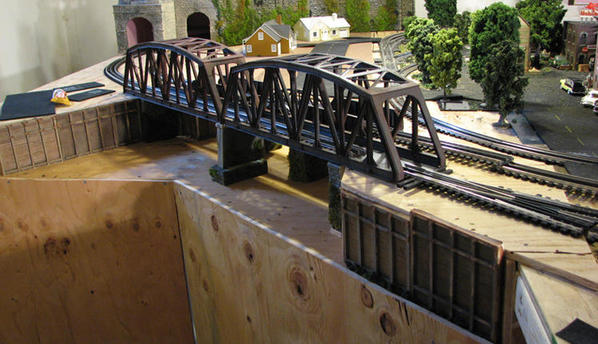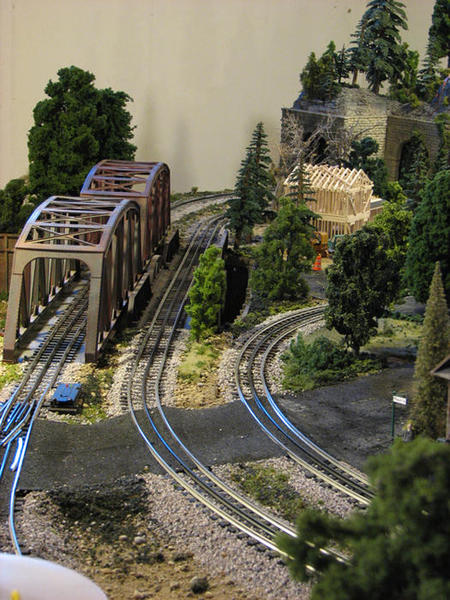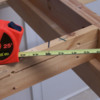what are the advantages of Gagraves track over Ross track or vice versa? Seems like most people recommend Ross switches and Gargraves track. Seems logical that if you were using Ross switches that you would want to use Ross track. I have always used FasTrack (love the command control switches with cab2) but fixing to begin construction on large 17x38’ layout and want to get it right the first time. Thanks in advance for your help!
Replies sorted oldest to newest
Ready for someone to correct me here, but I believe in quality there isn't much difference between the two in regular track but when it come to switches Ross is superior.
Also I'm thinking ( probably wrong again ) that at first Ross just did switches and track came as a later product. So everyone one got use to using Gargraves track with Ross switches. I see 14.5" and 29" straight track on there site for straight track but doesn't say if it's flex track or not so I'm guessing not. Gargaves straight track is 37" long
Gargraves seems to be known more for it's flextrack sections that allows you to bend any radius curve by hand, although it takes some basic skills. Their rails have a lower pair of flanges that ride in grooves cut into the wooden ties. This isn't seen if the final trackage is ballasted.
Ross, while known primarily for their high quality switches, seems to offer mostly sectional track. Like their switches, they fasten the rails to the top of the ties in a more traditional spike manner. Thus, their sectional track doesn't have the rail flange below the surface of the ties. Not sure if they make flex track.
I always assumed that Ross was a little more $$ across the board so people would spend it on their switches, which are critical, but save on the regular trackage where gargraves was both good enough and offered the flex sections.
Gargraves, plastic ties, Ross wood ties. Ross sectional track is much better looking and not as noisy.
Ross sectional curves if they say they are 0-72, they are 0-72. Gargrave if its 0-72 it might be 0-71, 0-73. It's never what it's stated.
My previous small layout was FasTrack, and I had no problems. The layout I am about to begin now (significantly larger) will be fitted with GarGraves track (both sectional and flex) and Ross switches. That last combo seems to be something of an accepted standard in the 3-rail world these days.
I just finished laying all Ross sectional track and switches on my 20 x 13 layout. I picked it because it looks better (spikes, rail entirely on top of the ties), and is only marginally more expensive than Gargraves. I still think so, but I can't say the process was easy. The 72" diameter curved sections are slightly too broad. That is to say, if you put 8 sections together, you end up with something less than 180 degrees and 2-3 inches too wide. I though I was crazy until a layout builder recently confirmed the problem, and told me that you have to bend the curves a bit (even though they're rigid) to make it work. Then, you end up having to re-trim the ends to make them square. Overall, I found it difficult to get kink-free curves, but the end result is nice-looking trackwork. Bottom line: if you want to stick sections together and run trains, I wouldn't use Ross. If you enjoy doing trackwork and appreciate how good Ross looks when painted and ballasted, go for it like I did.
Gargraves flex has wooden ties. If your building a large layout it's hard to beat Gargraves flex and Ross switches.
If you can't bend Gargraves track, then Ross sections are the way to go. Ross also stands behind it's products.
As stated above, people use gargraves flex to save a few bucks and spend it on the Ross switches for reliability and quality.
Building a pair of three rail additions to my 2 rail layout using GG track with Ross switches. My 3 rail track will be out of the way so appearance is not an issue. However the switches will be hard to access so I would ONLY use Ross switches!!!!!
The GG track is a little loosie goosie but very useable. The Ross track is more exacting.
The Ross track is more realistic in shape and attachment. The Ross track is more labor intensive in the manufacturing process so a tad more $$$
Both companies are great, each with a tremendous track record.
Buy a small quantity of each and decide for your self.
Due to appearance, consider using Ross track front and center for visitor impression.
Ross track and GG track are compatible. I like the owners of both companies.
IMO, only use Ross switches.
I have used Ross high quality turnouts and Gargraves wooden tie flextrack on 3 different layouts, one with over 400' of track, since the late 1980s. The flextrack enables custom curves that further enables more efficient use of limited space and placing of structures.
We are using Ross switches and sectional track, Gargraves where we want flextrack and are pleased with the results although there is a long way to go. We like the look with all Ross.
You didn't mention pricing but we were able to do better than list (40 X 22 so a good bit of track). If you want info, send me an e-mail.
Gargraves track with GG, Ross and right of way switches.
I use the Phantom and Stainless flex. I found the GG stainless to be a joy to work with. I have no issue with Phantom w/wood ties but the SS is so easy to work!!!
Another very happy Gargraves track, Ross switches person here. American made, very friendly/helpful staff, complementary products (Ross lists certain Gargraves items in their catalog/website that complement their product line without duplicating), excellent quality, competitive pricing (watch for the Ross ad comparing $$ to a popular off-shore brand), etc., etc.. Yes, Ross' genesis was in switches....now an extremely extensive line...,but now they have sectional track, too.
But I chose Gargraves track for another reason.....consistent appearance.
Gargraves is the only one of these two suppliers to have the flex track. While that's not necessary if you're laying long tangent (straight) trackwork, it is truly a godsend if you're trying to fit transitional curves into a free-form layout arrangement. OTOH, using GG flex track to make standard curves, while not impossible, is a lot of work to get consistent curvature and has some inherent waste associated with the process. So, for those portions of the layout using standard dimensional curves, I elected to use sectional preformed track.
Now BOTH Ross and Gargraves make sectional track in a variety of curvatures. However, Ross uses their standard technique of staples ('spikes') to fasten the rails to the wood ties, whereas GG uses additional stringers embedded and glued to the bottom of the wood ties to hold the curvature.
Since there is sufficient GG flex track throughout my rather large layout, I considered that the main track work would have a more consistent appearance if the preformed pieces also did not have the staples ('spikes'). So I used sectional GG track for that reason.
Then, too, I really like the plethora of 'spikes' in the Ross switches. It tends to celebrate (Norm Abrams term, not mine!) the switches, which they certainly deserve. But, if you look at prototype switches, the rail supports are beefier of necessity than just spikes. They stand out in appearance more significantly. So, I think the Ross switches have their own prototypical justification in appearance.
All in all, you will be pleased to build an O3R layout with either/both of these suppliers. We are truly blessed to have them a mainstays in our branch of model railroading. I've had more than a couple folks modeling in HO comment to me that they wish their branch of the hobby had TWO complementing AMERICAN suppliers of the quality, reliability, always-availability of Gargraves and Ross. And, you know?.........they're absolutely right!!!![]()
KD
Gentlemen,
I really love both Ross and GG for post war and modern train running. Remember however if you are a Tin Plate runner neither handles Tin Plate correctly.
Long ago we build the Iron Horse layout with GG and unfortunately my Tin did not run well on it at all.
The Ross Tin Plate Switches are Tin Plate in name only unfortunately.
PCRR/Dave
Too me either brand is a win win. I like the gargraves 37” for straights and any place a cut is necessary. I don’t try to bend it to a particular radius for a complete circle but will bend slightly to make things complete. Ross and Gargraves sectional curves are used for all major curves.
I agree. Ross switches and Gar Graves track. Ross makes very nice track. When you come right down to the finish line it is the person building his or her layout that has the final vote. As said bending Gar Graves takes a bit of getting use to. And another factor to possible consider is that Gar Graves offers more preformed curve track in different radius, with wood or plastic ties then any of the other manufacturers. .........Paul
Both brands of tracks are good. Gargraves flex is easy to bend while Ross tacks each rail to the tie and is not easily bent. I used mostly Gargraves Phantom Flex track on my layout as my curves are not standard. I just bend them on a plywood jig and screw them down as I lay the track. If you want 100% Ross then you must use their pre-bent curves. High quality track but more costly than Gargraves. As for switches the newer Gargraves is acceptable but Ross is really high end. Kind of like comparing a Chevrolet to a Cadillac. Once you start laying track don't forget the road bed material. I use the best, Midwest Cork- a rubberized cork composite material.
Working with Gargraves flex track and Ross switches. We built a large compass/gauge to assure the track curve was consistent.
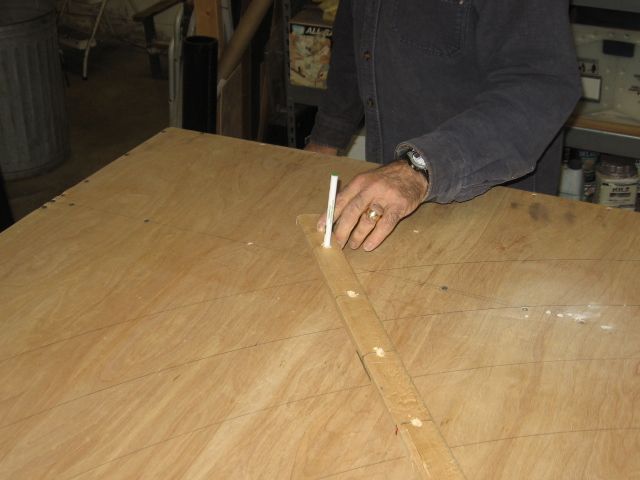
Ball point pen tip should always be on the center rail. Apply screws every 4" to 5".

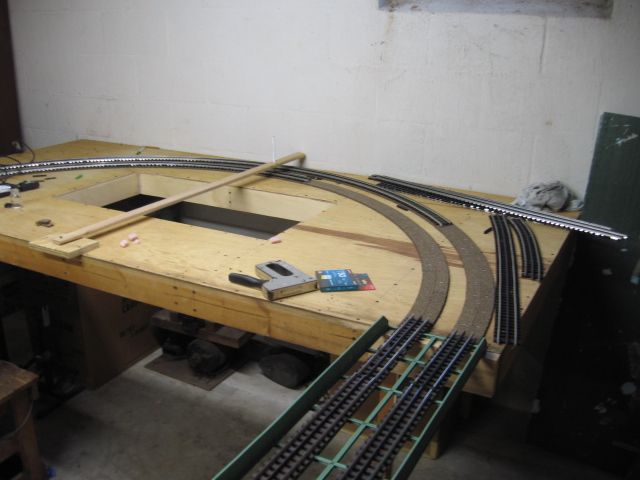



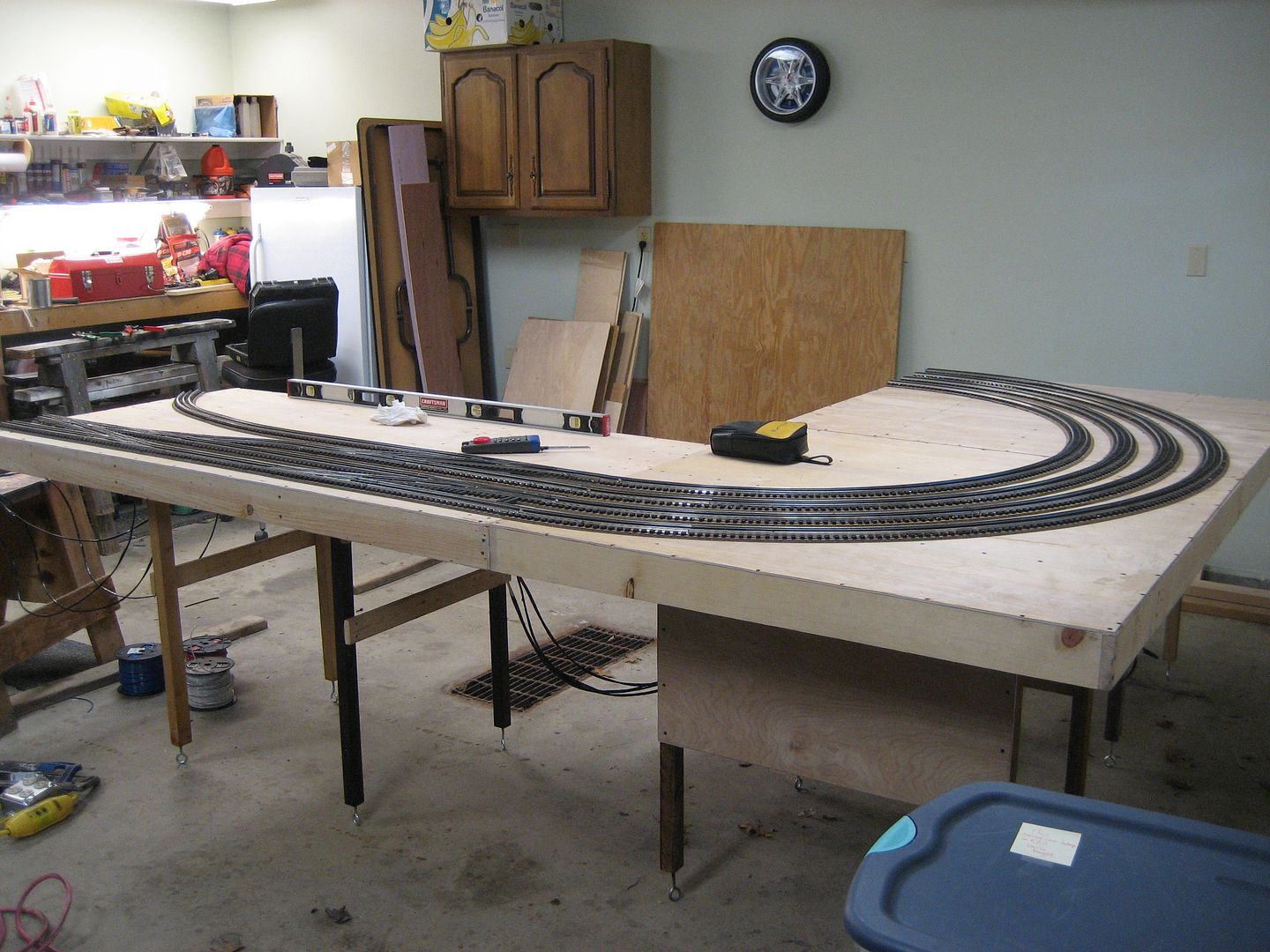
Allan Miller posted:My previous small layout was FasTrack, and I had no problems. The layout I am about to begin now (significantly larger) will be fitted with GarGraves track (both sectional and flex) and Ross switches. That last combo seems to be something of an accepted standard in the 3-rail world these days.
I agree with you, Allan. That is what I used on this layout....
....both of them, as you have explained.
FrankM
Attachments
superwarp1 posted:Gargraves, plastic ties, Ross wood ties. Ross sectional track is much better looking and not as noisy.
Ross sectional curves if they say they are 0-72, they are 0-72. Gargrave if its 0-72 it might be 0-71, 0-73. It's never what it's stated.
Compare apples to apples in other words compare Gargraves wood ties to ross wood ties. Gargraves does make wood ties track. Plastic is louder than wood anyday
GG makes plastic and wood ties. Their Stainless track with plastic ties is the top of the line track in my opinion only. Super easy to work with and bend, never gonna rust.
A homespun version of what Mike CT is doing above for precision custom curves: I have always used a spare tape with a drilled hole at the 1" mark for the 3p nail at the pivot point for swinging the radius to the center rail for installing flex track. The tape has holes drilled at the desired curve arc dimensions for marking with a Sharpie. For example, in the photo below the black mark on the joists is at the 43" tape hole for 084 (42" R) and the red mark is at the 37" hole for 072 (36"R). I mark the joists to enable extending rough wiring, and placing distribution strips prior to cover up for: connecting rail power at selected locations, for Tortoise motors, switchstand lights and lighting for planned structures. I follow the same procedure on the layout surface for installing split cork roadbed to the marked centerline and bend the track center rail to the cork center as I advance from trailing end to leading end, removing excess ties and installing screws every 8-9 ties as I bend, fasten and drive up the rails for a loose fit at the trailing end. Then I ease the tracks inward at the trailing joint until center rail at the track joint is precisely over the cork center and install screws. Then lightly drive up rails but not jam tight. How to achieve a perfect curve at the track joint.
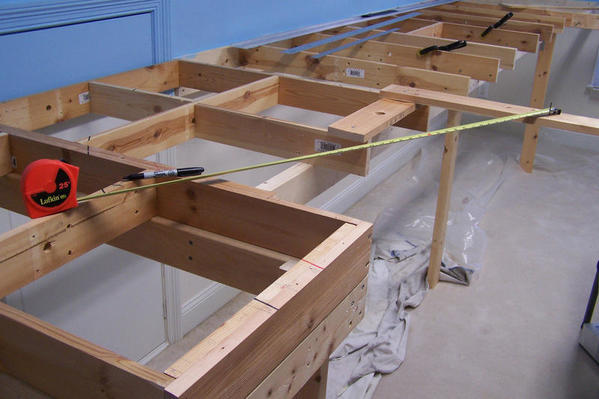

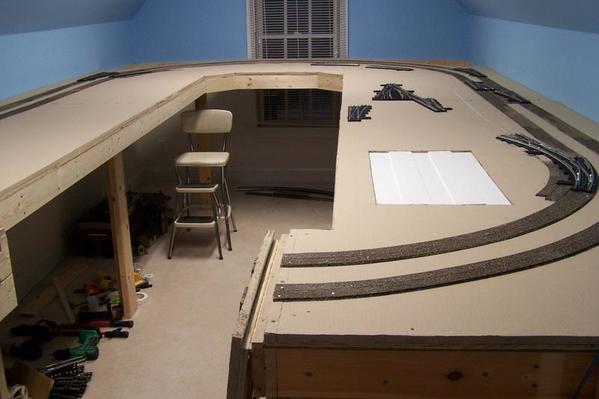
Attachments
Bobby, as you can see both brands are top notch. It now comes down to you. Let us know what you decide.
superwarp1 posted:Gargraves, plastic ties, Ross wood ties. Ross sectional track is much better looking and not as noisy.
Ross sectional curves if they say they are 0-72, they are 0-72. Gargrave if its 0-72 it might be 0-71, 0-73. It's never what it's stated.
Gargraves also has wood tie track.
I do things a bit differently I use tubular on the portion of my layout that I want a 50s look . I then connect Gargraves to it and use disguised Lionel switches where I want more realism. I used a wine barrel from one of my other hobbies to bend the Gg track O42 near the end O72 closer to the middle.
Al Smeraldo posted:I do things a bit differently I use tubular on the portion of my layout that I want a 50s look . I then connect Gargraves to it and use disguised Lionel switches where I want more realism. I used a wine barrel from one of my other hobbies to bend the Gg track O42 near the end O72 closer to the middle.
I would just point out that mixing P/W Lionel track with Gargraves or Ross requires using conversion pins. Just thought that I'd make this clear for the new forum member.
Also there is a height difference between Gargraves and tinplate lionel O. If the lionel O is laid without cork roadbed the addition of cork roadbed to the GG matches them up. In my case the tinplate O is on cork so I just added a second layer of cork under the GG and tapered it down. There is no problem with O27 as it is the same height as GG. The lionel switches work great and I have bought used ones for $20 a pair at train shows the iniital curve is 031 but I have cut some of them down to mitigate that. The 072 ones are rarer and more expensive.
I could not use Ross because in Hawaii I MUST have corrosion resistant track. I found GarGraves was too easy to deform when I used it on the floor; invariably someone would step on it or something, and while that is probably not a problem on my layout where it no one is (usually) walking or kneeling, the solid rails of Atlas nickel silver track solved both of those problems, so I used that. My old Lionel tin plate track was only good for a couple of years before it rusted too much to use. I also found that the wood ties on GarGraves track tend to break off fairly easily outside the trackage.
Bob
Bob, all of those issues go away if it's not getting walked on. I agree, Atlas track is pretty bulletproof, it's a shame their switches are sub-standard. I would have used Atlas track if it were even close to the price of Gargraves, but three times the price made my decision easy.
You can get Gargraves with plastic ties and stainless rail if you have a high moisture environment. Ross also has stainless track and switches.
Yes, though I have had to kneel on the layout track a few times. I have all the track I need now, and at the time I was buying track, Ross told me they had no stainless track. Good to know, though! Thanks for the feedback.
All the GarGraves track I have is stainless, with a mix of plastic and wooden ties.
Bob
We used Ross switches on our 12 x 16 layout because of their quality and the variety of switches available. We mainly used Gargraves flex track so that we could have the wide 072 curves we wanted but also avoid the geometrical sameness of having all pre made 072 track. The disadvantage of Gargraves flex track for me is the web of the track that extends into the ties. When unballasted, the visible silver rail below the ties is bothersome. Since we were going to ballast the track this would not be a problem. However, we had to build wood trestles leading into both ends of an Atlas truss bridge. If we used Gargraves, the unsightly web below the ties would show. So to avoid that we used the excellent looking 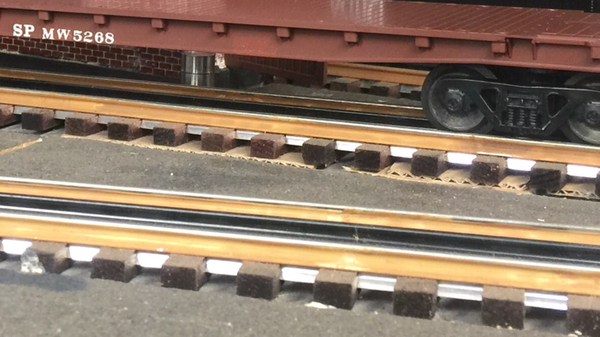
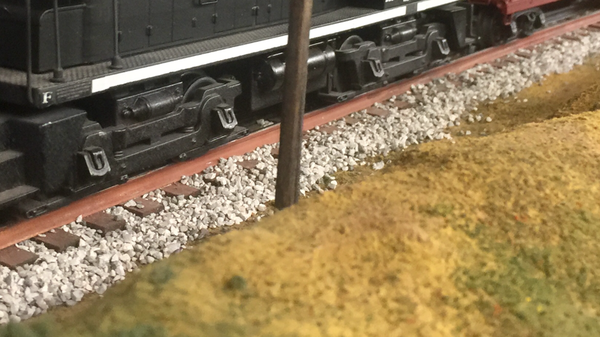
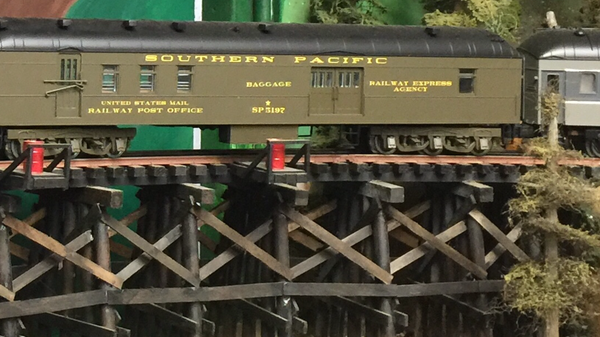 Ross sectional track, and it was exactly what we needed.
Ross sectional track, and it was exactly what we needed.
I am including 3 photos. First, Gargraves flex track unballasted. Second, Gragraves flex track with ballast. Third, Ross sectional track on a trestle.
Attachments
For laying out curves a camera tripod can be helpful:
The blue tape marks tripod foot placement for other curve centers
<--Laying out easement. As long as you are using flex track think about incorporating a spiral easement.
Spiral easement instructions are on the NMRA website's recommended standards and practices under spiral easements. I not sure but it may be S-8??
Below are what spiral easements can look like. A nice gentle entrance to a curve, gradually tightening up to the final radius. The tight curve of the underpass curve demonstrates the gradual spiral easement entrance and exit of a curve.
Because the total amount of curvature is somewhat small the upper grade primarily is formed by mainly just the easement. There is only about30" of fixed radius in the upper right of way.
Attachments
@Tom Tee posted:For laying out curves a camera tripod can be helpful:
Tom, these are some great tips for laying out curves (especially on a larger more complex layout). I think they would also be applicable to most track types.
Thanks for posting them.
To Make things a bit easier you can make up templates of the curves your will be using, that way the establishment of the right of ways will be much quicker and easier.
Templates are very useful when going around an outside corner where a trammel cannot be used.
Everybody's templates will be different depending on their application. Building my branch line RR, the templates range from 49" to 76" radius.
Note the gradual transition from tangent to full radius.
Attachments
@Bobby Cox posted:what are the advantages of Gagraves track over Ross track or vice versa? Seems like most people recommend Ross switches and Gargraves track. Seems logical that if you were using Ross switches that you would want to use Ross track. I have always used FasTrack (love the command control switches with cab2) but fixing to begin construction on large 17x38’ layout and want to get it right the first time. Thanks in advance for your help!
I built my 8x8 layout with Gargraves bendable track. Wooden ties. Couldn't be happier.
I wish I would have gone with Ross switches, though.
(2) My 8x8 O Gauge layout - YouTube
Ponz
Gargraves track has a skirt that extends below the top of the ties that is part of each rail. Some say it makes it harder to ballast.
Ross track has an additional wood strip under the rails to strengthen the track. Based on your use you decide.
Gargraves also makes switches, I've installed several, they are reliable, IMO. Track pins are slightly different, Gargraves pins are larger.
Gargraves left, Ross Right.





